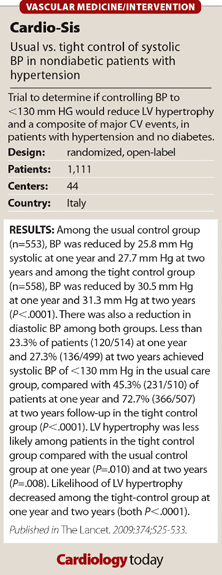Cardio-Sis: Tight BP control bested usual control among patients without diabetes
Study results suggest a BP goal <140 mm Hg systolic among patients with hypertension, without diabetes.
Study results from the Cardio-Sis open-label trial show that patients who have hypertension but no diabetes respond well to tight control (<130 mm Hg), suggesting the recommended goal of <140 mm Hg could be reduced.
In 44 Italian centers, researchers randomized patients without diabetes with systolic BP >150 mm Hg to usual control (goal systolic BP of <140 mm Hg; n=553) or tight control (goal of systolic BP <130 mm Hg; n=558). According to the study, the primary endpoint was prevalence of ECG left ventricular hypertrophy after two years; The secondary endpoint was a number of cardiovascular outcomes, including all-cause mortality, NYHA III or IV congestive HF requiring hospitalization, fatal or nonfatal MI, transient ischemic attack, coronary revascularization and new onset atrial fibrillation. The researchers performed follow-up with patients every four months for two years. The researchers used a variety of antihypertensive medications to achieve BP reduction.
Among the usual control group, BP was reduced by 25.8 mm Hg systolic at one year and 27.7 mm Hg at two years and among the tight control group, BP was reduced by 30.5 mm Hg at one year and 31.3 mm Hg at two years (P<.0001). There was also a reduction in diastolic BP among both groups.
Less than 23.3% of patients (120/514) at one year and 27.3% (136/499) at two years achieved systolic BP of <130 mm Hg in the usual care group, compared with 45.3% (231/510) of patients at one year and 72.7% (366/507) at two years follow-up in the tight control group (P<.0001). LV hypertrophy was less likely among patients in the tight control group compared with the usual control group at one year (P=.010) and at two years (P=.008). Likelihood of LV hypertrophy decreased among the tight-control group at one year and two years (both P<.0001).
“Findings from our trial have shown that setting a systolic target of <130 mm HG instead of the usual 140 mm HG in patients with treatment-resistant systolic hypertension was feasible and well tolerated,” the researchers said in their discussion.

Verdecchia P. The Lancet. 2009:374;525-533
